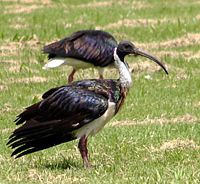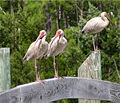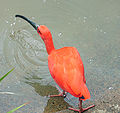Ibis
| Ibis | ||||||||||||
|---|---|---|---|---|---|---|---|---|---|---|---|---|
 Straw-necked Ibis
| ||||||||||||
| Scientific classification | ||||||||||||
| ||||||||||||
|
Ibis is the common name for any of the long-legged wading birds of diverse genera comprising the subfamily Threskiornithinae of the family Threskiornithidae, characterized by a long, slender beak that curves downward. These stork-like birds belong to the same family as the spoonbills, but the spoonbills have a flat beak that does not curve downward and is somewhat enlarged at the tip. There are about thirty species of ibises, placed into 12 genera.
Overview and description
The ibis family, Threskiornithidae, includes two groups of large terrestrial and wading birds, placed into two subfamilies: the ibises, comprising the subfamily Threskornithinae, and the spoonbills comprising the subfamily Plataleinae. There are about 35 species and 13 or 14 genera in the family. Twelve of the genera in Threskornithidae, with 29 extant species, are known as ibises: Bostrychia (African ibises), Cercibis (sharp-tailed ibis), Eudocimus (white and scarlet ibises), Geronticus (bald ibises), Lophotibis (Madagascan crested ibis), Mesembrinibis (green ibis), Nipponia (crested ibis), Phimosus (bare-faced ibis), Plegadis (glossy ibises), Pseudibis (South Asian ibises), Theristicus (South American ibises), and Threskiornis (sacred ibis and relatives) (Myers et al. 2008a). One or two genera, with six extant species, are known as spoonbills and comprise the subfamily Plataleinae: Platalea (Old World spoonbills) and Ajaia (American spoonbills) (Myers et al. 2008b), but sometimes only Platalea is recognized (IBIS 1998a). The family formally was known as Plataleidae.
The spoonbills and ibises were once thought to be related to other groups of long-legged wading birds in the order Ciconiiformes, including the storks, the herons, and the bitterns. But recent study suggest that they belong to the Pelecaniformes (Hackett et al. 2008). Whether the two subfamilies are reciprocally monophyletic is an open question. The South American Checklist Committee's entry for the Threskiornithidae includes the following comment: "Two subfamilies are traditionally (e.g., Matheu and del Hoyo 1992) recognized: Threskiornithinae for ibises and Plataleinae for spoonbills; because the main distinction has to do with bill shape, additional information, especially genetic, is required to recognize a major, deep split in the family" (SACC-AOU 2002).
Members of the family, both ibises and spoonbills, are typified by long, broad wings with 11 primary feathers and about 20 secondaries. They are strong fliers and, rather surprisingly, given their size and weight, very capable soarers. The body tends to be elongated, the neck more so, with rather long legs. The bill is also long, decurved in the case of the ibises, straight and distinctively flattened in the spoonbills. They are large birds, but mid-sized by the standards of their order, ranging from the Dwarf Olive Ibis (Bostrychia bocagei), at 45 cm (18 in) and 450 g (1 lb), to the Giant Ibis (Thaumatibis gigantea), at 100 cm (40 in) and 4.2 kg (9.2 lb).
The ibises (pronounced [ˈaɪbɨ̞sɨ̞z]) are a group of long-legged wading birds in the family Threskiornithidae. They all have long down curved bills, and usually feed as a group, probing mud for food items, usually crustaceans. Most species nest in trees, often with spoonbills or herons.
The word ibis comes from Greek, originally borrowed from Ancient Egyptian hîb.
Folklore
The Sacred Ibis was an object of religious veneration in ancient Egypt, particularly associated with the god, Thoth. At the town of Hermopolis, ibises were reared specifically for sacrificial purposes and in the Serapeum at Saqqara, archaeologists found the mummies of one and a half million ibises and hundreds of thousands of falcons.[1]
Species in taxonomic order
- Genus Threskiornis
- Sacred Ibis, Threskiornis aethiopicus
- Madagascar Sacred Ibis, Threskiornis bernieri
- Réunion Sacred Ibis, Threskiornis solitarius extinct
- Black-headed Ibis, Threskiornis melanocephalus
- Australian White Ibis, Threskiornis molucca
- Straw-necked Ibis, Threskiornis spinicollis
- Genus Pseudibis
- Indian Black Ibis, Pseudibis papillosa
- White-shouldered Ibis, Pseudibis davisoni
- Genus Thaumatibis
- Giant Ibis, Thaumatibis gigantea
- Genus Geronticus
- Northern Bald Ibis, Geronticus eremita
- Southern Bald Ibis, Geronticus calvus
- Genus Nipponia
- Japanese Crested Ibis, Nipponia nippon
- Genus Bostrychia
- Olive Ibis, Bostrychia olivacea
- Dwarf Olive Ibis, Bostrychia bocagei
- Spot-breasted Ibis, Bostrychia rara
- Hadada Ibis, Bostrychia hagedash
- Wattled Ibis, Bostrychia carunculata
- Genus Theristicus
- Plumbeous Ibis, Theristicus caerulescens
- Buff-necked Ibis, Theristicus caudatus
- Black-faced Ibis, Theristicus melanopis
- Genus Cercibis
- Sharp-tailed Ibis, Cercibis oxycerca
- Genus Mesembrinibis
- Green Ibis, Mesembrinibis cayennensis
- Genus Phimosus
- Whispering Ibis, Phimosus infuscatus
- Genus Eudocimus
- American White Ibis, Eudocimus albus
- Scarlet Ibis, Eudocimus ruber
- Genus Plegadis
- Glossy Ibis, Plegadis falcinellus
- White-faced Ibis, Plegadis chihi
- Puna Ibis, Plegadis ridgwayi
- Genus Lophotibis
- Madagascar Crested Ibis, Lophotibis cristata
Gallery
- Scibis500.jpg
Sacred Ibis
ReferencesISBN links support NWE through referral fees
- ↑ Fleming, Furgus; Alan Lothian; Duncan Baird Publishers. The Way to Eternity: Egyptian Myth. Amsterdam: Time-Life Books. 1997. pp. 66-67
Endangered Wildlife and Plants of the World By Marshall Cavendish Corporation, Marshall Cavendish Corporation Edition: illustrated Published by Marshall Cavendish, 2001 ISBN 0761471995, 9780761471998
- Integrated Taxonomic Information System (ITIS). 1998. Threskiornithidae ITIS Taxonomic Serial No.: 174922. Retrieved February 10, 2009.
- Myers, P., R. Espinosa, C. S. Parr, T. Jones, G. S. Hammond, and T. A. Dewey. 2008a. Subfamily Threshkiornithinae (ibises). Animal Diversity Web. Retrieved February 10, 2009.
- Myers, P., R. Espinosa, C. S. Parr, T. Jones, G. S. Hammond, and T. A. Dewey. 2008b. Threshkiornithidae (ibises and spoonbills). Animal Diversity Web. Retrieved February 10, 2009.
[1]) A classification of the bird species of South America South American Classification Committee (SACC-AOU) American Ornithologists' Union 2002
External links
- Ibis videos - at Internet Bird Collection
Credits
New World Encyclopedia writers and editors rewrote and completed the Wikipedia article in accordance with New World Encyclopedia standards. This article abides by terms of the Creative Commons CC-by-sa 3.0 License (CC-by-sa), which may be used and disseminated with proper attribution. Credit is due under the terms of this license that can reference both the New World Encyclopedia contributors and the selfless volunteer contributors of the Wikimedia Foundation. To cite this article click here for a list of acceptable citing formats.The history of earlier contributions by wikipedians is accessible to researchers here:
The history of this article since it was imported to New World Encyclopedia:
Note: Some restrictions may apply to use of individual images which are separately licensed.
- ↑ A Phylogenomic Study of Birds Reveals Their Evolutionary History. Shannon J. Hackett, et al. Science 320, 1763 (2008).




